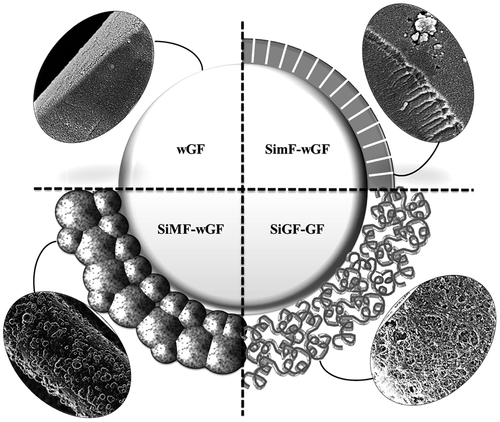当前位置:
X-MOL 学术
›
ACS Appl. Polym. Mater.
›
论文详情
Our official English website, www.x-mol.net, welcomes your feedback! (Note: you will need to create a separate account there.)
Improving Mechanical Properties of Glass Fiber Reinforced Polymers through Silica-Based Surface Nanoengineering
ACS Applied Polymer Materials ( IF 5 ) Pub Date : 2020-06-05 , DOI: 10.1021/acsapm.0c00295 Mohammad J. Ghasemi Parizi 1, 2 , Hossein Shahverdi 2 , Joan Josep Roa 3, 4 , Ehsan Pipelzadeh 1, 5 , Monica Martinez 6 , Andreu Cabot 1, 7 , Pablo Guardia 1
ACS Applied Polymer Materials ( IF 5 ) Pub Date : 2020-06-05 , DOI: 10.1021/acsapm.0c00295 Mohammad J. Ghasemi Parizi 1, 2 , Hossein Shahverdi 2 , Joan Josep Roa 3, 4 , Ehsan Pipelzadeh 1, 5 , Monica Martinez 6 , Andreu Cabot 1, 7 , Pablo Guardia 1
Affiliation

|
Glass fiber reinforced polymer (GFRP) composites are widely used materials in structural and transport applications owing to their excellent strength-to-weight ratio. In GFRPs, mechanical properties are mainly governed by the filler-to-matrix interphase region, which need to be rationally designed and carefully engineered to optimize the composite performance. However, the structural and chemical parameters that optimize mechanical performance are partially unknown. Here, we report on different surface nanoengineering strategies and their effect on the mechanical properties of GFRPs. Commercial woven glass fibers (wGFs) are modified with several distinct silica-based nanostructured coatings that provide different pore sizes, surface areas, and adhesion energies. To study their mechanical properties, epoxy–wGF laminated composites are manufactured and characterized using sliding contact, tensile, and three-point bending tests. Composites based on coated wGFs generally show improved mechanical performance over those based on bare wGFs. In particular, wGFs coated with mesoporous silica films display the highest specific surface areas, pore sizes and adhesion energies and provide the highest Young’s and flexural modulus, with up to 31% improvement with respect to composites based on bare wGFs. The improvement of the composite’s mechanical properties with the wGFs coating is related to a better stress distribution and a homogeneous loading transfer at the polymer–GF interphase. Overall, this study provides insights on how GFRP’s mechanical properties can be boosted beyond the current state-of-the-art by the rational design of its interphase.
中文翻译:

通过二氧化硅基表面纳米工程改善玻璃纤维增强聚合物的机械性能
玻璃纤维增强聚合物(GFRP)复合材料因其出色的强度重量比而在结构和运输应用中被广泛使用。在玻璃纤维增强塑料中,机械性能主要受填料与基体的相间区域支配,需要合理设计和仔细设计以优化复合材料的性能。但是,优化机械性能的结构和化学参数部分未知。在这里,我们报告了不同的表面纳米工程策略及其对GFRPs力学性能的影响。商业机织玻璃纤维(wGF)用几种不同的二氧化硅基纳米结构涂层改性,这些涂层提供不同的孔径,表面积和粘附能。要研究它们的机械性能,环氧-wGF层压复合材料是通过滑动接触,拉伸和三点弯曲测试制造和表征的。与基于裸露的wGFs的复合材料相比,基于涂层的wGFs的复合材料通常显示出更高的机械性能。尤其是,涂有介孔二氧化硅薄膜的wGF表现出最高的比表面积,孔径和粘附能,并具有最高的杨氏模量和挠曲模量,相对于基于裸露wGF的复合材料,其提高了31%。wGFs涂层改善了复合材料的机械性能,这与更好的应力分布和聚合物-GF界面处的均匀载荷转移有关。总的来说,这项研究提供了有关如何合理设计相间结构来提高GFRP的机械性能的见解。
更新日期:2020-07-10
中文翻译:

通过二氧化硅基表面纳米工程改善玻璃纤维增强聚合物的机械性能
玻璃纤维增强聚合物(GFRP)复合材料因其出色的强度重量比而在结构和运输应用中被广泛使用。在玻璃纤维增强塑料中,机械性能主要受填料与基体的相间区域支配,需要合理设计和仔细设计以优化复合材料的性能。但是,优化机械性能的结构和化学参数部分未知。在这里,我们报告了不同的表面纳米工程策略及其对GFRPs力学性能的影响。商业机织玻璃纤维(wGF)用几种不同的二氧化硅基纳米结构涂层改性,这些涂层提供不同的孔径,表面积和粘附能。要研究它们的机械性能,环氧-wGF层压复合材料是通过滑动接触,拉伸和三点弯曲测试制造和表征的。与基于裸露的wGFs的复合材料相比,基于涂层的wGFs的复合材料通常显示出更高的机械性能。尤其是,涂有介孔二氧化硅薄膜的wGF表现出最高的比表面积,孔径和粘附能,并具有最高的杨氏模量和挠曲模量,相对于基于裸露wGF的复合材料,其提高了31%。wGFs涂层改善了复合材料的机械性能,这与更好的应力分布和聚合物-GF界面处的均匀载荷转移有关。总的来说,这项研究提供了有关如何合理设计相间结构来提高GFRP的机械性能的见解。



























 京公网安备 11010802027423号
京公网安备 11010802027423号